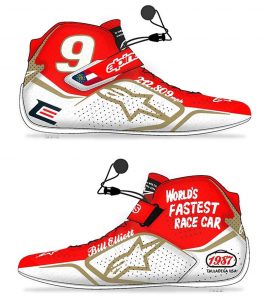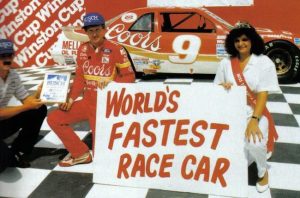Records are meant to be broken, but there are some that have stood the test of time.
Joe DiMaggio established his 56-game hitting streak in Major League Baseball with the New York Yankees in 1941.
Will Chamberlain scored 100 points in a National Basketball Association game for the Philadelphia Warriors on March 2, 1962.
Secretariat’s march to the 1973 Triple Crown began in the Kentucky Derby when he covered the one-and-a-quarter-mile distance at Churchill Downs in 1 minute, 59.4 seconds.
When it comes to the world of stock car racing, Richard Petty rules the roost with 200 career Monster Energy NASCAR Cup Series victories, but in terms of sheer speed, well, the man who stands on the top of that mountain is Bill Elliott.
This week marks the 30th anniversary of when Elliott set NASCAR’s record speed of 212.809 mph while qualifying his No. 9 Coor’s Ford Thunderbird for the annual Winston 500 at Talladega Superspeedway in 1987. The record, which came on the heels of his 210.364 mph mark at Daytona just a couple of months earlier, further cemented his place in NASCAR lore.
“At Talladega you don’t feel the speed like you do at Daytona because of the transitions and tightness of the corners,” recalled Elliott when comparing the two records. “Talladega was built for those speeds and the transitions were so much easier. You picked up the bank before you got to the corner at Talladega while Daytona was totally the opposite, you kind of ran in the corner before you picked up all of the banking.”
Neither, however, was easy as evidenced by the lengths teams went to during that record-setting qualifying session at Talladega.
“You still had to do everything you could to make the car really uncomfortable to run fast. There were guys over there before qualifying taking the rear spoilers off, but you couldn’t drive them,” said Elliott. “You had to have a little bit of downforce or you couldn’t drive them, so you just had to get to that point where you took as much off as you could and still be able to make it around the race track.”
In the end, Elliott was hoping to go even faster than he did, but it didn’t matter to the people in the grandstands. They were beyond thrilled.
 “The fans went nuts. They loved it. They loved that stuff back then. The faster the better,” said Elliott, who was voted NASCAR’s Most Popular Driver a record 16 times during his career. “We had worked so hard to get to that point that it was very satisfying from our end. We put a lot of effort into our speedway programs and already had really good power, so we were able to kind of marry it all together.”
“The fans went nuts. They loved it. They loved that stuff back then. The faster the better,” said Elliott, who was voted NASCAR’s Most Popular Driver a record 16 times during his career. “We had worked so hard to get to that point that it was very satisfying from our end. We put a lot of effort into our speedway programs and already had really good power, so we were able to kind of marry it all together.”
The feat came in the midst of a remarkable run for Elliott, who claimed the inaugural “Winston Million” bonus in 1985 after winning three of the four ‘crown jewel’ races on the schedule that season. He ended up winning 19 times on superspeedways from 1985-87 and capped it off with a series championship in 1988.
“I think the qualifying record at Talladega just kind of puts an exclamation point on our legacy. I’m talking about for our whole family – me, Dan, Ernie and my dad,” said Elliott. “We came out of nothing. We came out of a little town in Dawsonville, Georgia that wasn’t even on the map. We were kind of like David and Goliath with what we did and what we accomplished.”
Elliott’s record remains intact largely because a day after setting the mark Bobby Allison’s car got airborne during the race, damaging the catch fence and injuring some spectators. That led NASCAR to implement the use of restrictor plates at Daytona and Talladega, ensuring speeds were kept well below Elliott’s new standard.
“It would be broken easily if you had the latitude to do the things that we did as far as taking more drag out of the car, but with the current configuration and the spoilers they run on the cars today, it won’t be broken,” said Elliott, who ranks second on Ford’s all-time MENCS win list with 40. “But it’s dictated by the evolution of the sport and the safety of the drivers. That being said, if you unrestricted the cars, and with the way technology is today, I don’t know why they wouldn’t go over there and run 225-230. I mean, we had 625 horsepower back then and now they’ve got 850 to the rear wheels. If you put all of that together today, the sky is the limit.”
Elliott’s record-setting Thunderbird is still alive and well, having been donated by car owner Harry Melling to The Henry Ford Museum of American Innovation in Dearborn, MI. There it proudly sits on display with many other iconic vehicles, telling a unique story and standing the test of time.


